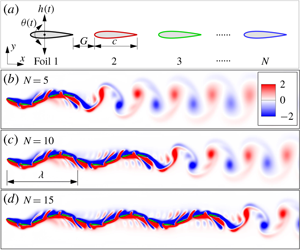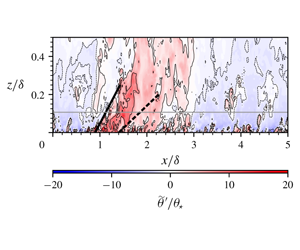JFM Rapids
Self-organization of multiple self-propelling flapping foils: energy saving and increased speed
-
- Published online by Cambridge University Press:
- 05 December 2019, R1
-
- Article
- Export citation
Convergent Richtmyer–Meshkov instability of light gas layer with perturbed outer surface
-
- Published online by Cambridge University Press:
- 17 December 2019, R2
-
- Article
- Export citation
Streaky dynamo equilibria persisting at infinite Reynolds numbers
-
- Published online by Cambridge University Press:
- 17 December 2019, R3
-
- Article
- Export citation
Shock–shock interactions in granular flows
-
- Published online by Cambridge University Press:
- 17 December 2019, R4
-
- Article
- Export citation
Revisiting inclination of large-scale motions in unstably stratified channel flow
-
- Published online by Cambridge University Press:
- 17 December 2019, R5
-
- Article
- Export citation
Liquid velocity fluctuations and energy spectra in three-dimensional buoyancy-driven bubbly flows
-
- Published online by Cambridge University Press:
- 17 December 2019, R6
-
- Article
- Export citation
A heat transfer model of fully developed turbulent channel flow
-
- Published online by Cambridge University Press:
- 17 December 2019, R7
-
- Article
- Export citation
Focus on Fluids
Stokes drift: theory and experiments
-
- Published online by Cambridge University Press:
- 05 December 2019, F1
-
- Article
-
- You have access
- HTML
- Export citation
JFM Papers
Analysis of a civil aircraft wing transonic shock buffet experiment
-
- Published online by Cambridge University Press:
- 03 December 2019, A1
-
- Article
-
- You have access
- Open access
- HTML
- Export citation
On the mechanism of open-loop control of thermoacoustic instability in a laminar premixed combustor
-
- Published online by Cambridge University Press:
- 03 December 2019, A2
-
- Article
- Export citation
The hydroelastic response of a surface-piercing hydrofoil in multiphase flows. Part 2. Modal parameters and generalized fluid forces
-
- Published online by Cambridge University Press:
- 03 December 2019, A3
-
- Article
- Export citation
Flow–acoustic resonance in a cavity covered by a perforated plate
-
- Published online by Cambridge University Press:
- 03 December 2019, A4
-
- Article
- Export citation
The alignment of vortical structures in turbulent flow through a contraction
-
- Published online by Cambridge University Press:
- 03 December 2019, A5
-
- Article
-
- You have access
- Open access
- HTML
- Export citation
The effect of double diffusion on entrainment in turbulent plumes
-
- Published online by Cambridge University Press:
- 03 December 2019, A6
-
- Article
- Export citation
Characteristics of turbulent square duct flows over porous media
-
- Published online by Cambridge University Press:
- 03 December 2019, A7
-
- Article
- Export citation
Effects of flapping-motion profiles on insect-wing aerodynamics
-
- Published online by Cambridge University Press:
- 03 December 2019, A8
-
- Article
- Export citation
Electrophoresis in dilute polymer solutions
-
- Published online by Cambridge University Press:
- 05 December 2019, A9
-
- Article
- Export citation
Nonlinear evolution and acoustic radiation of coherent structures in subsonic turbulent free shear layers
-
- Published online by Cambridge University Press:
- 05 December 2019, A10
-
- Article
- Export citation
Planar hydraulic jumps in thin film flow
-
- Published online by Cambridge University Press:
- 05 December 2019, A11
-
- Article
- Export citation
The mode B structure of streamwise vortices in the wake of a two-dimensional blunt trailing edge
-
- Published online by Cambridge University Press:
- 05 December 2019, A12
-
- Article
- Export citation
































































